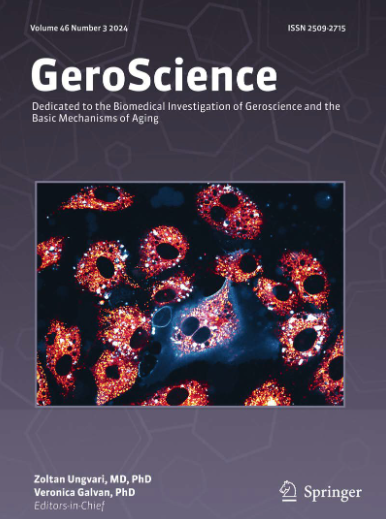Analysis of variability and epigenetic age prediction across microarray and methylation sequencing technologies.
IF 5.4
2区 医学
Q1 GERIATRICS & GERONTOLOGY
引用次数: 0
Abstract
Using 100 technical replicate samples from two adult buccal cohorts, we compared technical methylation variability and signal strength between the Infinium MethylationEPIC v2.0 array and the Twist Human Methylome Panel across 753,648 shared CpGs. Twist methylation sequencing showed skewed methylation distributions and fewer highly correlated CpGs than MethylationEPIC arrays. Variance analysis revealed a skew toward higher signal strength in MethylationEPIC datasets, with a subset of CpGs showing high signal strength in both methylation sequencing and array datasets. Despite these biases, four principal component (PC) trained epigenetic clocks (pcHorvath1, pcHorvath2, pcHannum, and pcDNAm PhenoAge) were robust across both technologies, even with missing data. While pcHannum and pcDNAm PhenoAge were similarly reproducible with mean absolute replicate difference (MRD) values ranging from 1.014 years to 1.194 years, pcHorvath1 was more reproducible in arrays (MRD = 0.459 years) than methylation sequencing (MRD = 2.320 years) and pcHorvath2 was more reproducible in methylation sequencing (MRD = 0.760 years) than arrays (MRD = 1.011 years). Furthermore, original non-PC versions of these clocks were less reproducible in Twist datasets and, as an example of this, MRD for uncorrected clocks went as high as 15.498 years in arrays and as high as 20.180 years in methylation sequencing. Obvious differences in age prediction were also observed in original clocks compared to their PC-trained versions across both technologies (with a mean absolute difference ranging from 4.492 years to 46.724 years). This underscores the need for careful selection of epigenetic clocks and technology-specific adjustments when optimizing for accuracy and reproducibility.微阵列和甲基化测序技术的变异性分析和表观遗传年龄预测。
使用来自两个成人口腔队列的100个技术重复样本,我们比较了Infinium MethylationEPIC v2.0阵列和Twist Human Methylome Panel之间的技术甲基化变异性和信号强度,涉及753,648个共享的CpGs。与MethylationEPIC阵列相比,Twist甲基化测序显示甲基化分布偏斜,高相关CpGs较少。方差分析显示,在MethylationEPIC数据集中,CpGs的一个子集在甲基化测序和阵列数据集中都显示出高信号强度。尽管存在这些偏差,四个主成分(PC)训练的表观遗传时钟(pcHorvath1, pcHorvath2, pcHannum和pcDNAm PhenoAge)在两种技术中都是稳健的,即使缺少数据。pcHannum和pcDNAm表型具有相似的可重复性,平均绝对重复差(MRD)值在1.014 ~ 1.194年之间,pcHorvath1在测序序列中的可重复性(MRD = 0.459年)高于甲基化测序(MRD = 2.320年),pcHorvath2在测序序列中的可重复性(MRD = 0.760年)高于测序序列(MRD = 1.011年)。此外,这些时钟的原始非pc版本在Twist数据集中的可重复性较差,例如,未校正时钟的MRD在阵列中高达15.498年,在甲基化测序中高达20.180年。在两种技术中,原始时钟与pc训练版本的年龄预测也存在明显差异(平均绝对差异从4.492岁到46.724岁不等)。这强调了在优化准确性和可重复性时仔细选择表观遗传时钟和技术特定调整的必要性。
本文章由计算机程序翻译,如有差异,请以英文原文为准。
求助全文
约1分钟内获得全文
求助全文
来源期刊

GeroScience
Medicine-Complementary and Alternative Medicine
CiteScore
10.50
自引率
5.40%
发文量
182
期刊介绍:
GeroScience is a bi-monthly, international, peer-reviewed journal that publishes articles related to research in the biology of aging and research on biomedical applications that impact aging. The scope of articles to be considered include evolutionary biology, biophysics, genetics, genomics, proteomics, molecular biology, cell biology, biochemistry, endocrinology, immunology, physiology, pharmacology, neuroscience, and psychology.
 求助内容:
求助内容: 应助结果提醒方式:
应助结果提醒方式:


